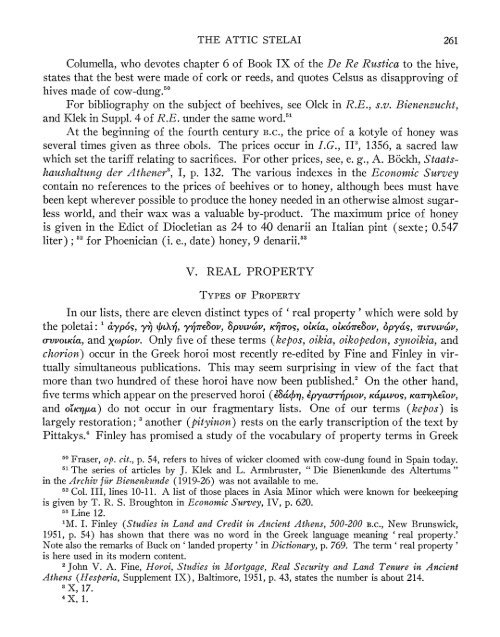the attic stelai - The American School of Classical Studies at Athens
the attic stelai - The American School of Classical Studies at Athens
the attic stelai - The American School of Classical Studies at Athens
Create successful ePaper yourself
Turn your PDF publications into a flip-book with our unique Google optimized e-Paper software.
THE ATTIC STELAI 261<br />
Columella, who devotes chapter 6 <strong>of</strong> Book IX <strong>of</strong> <strong>the</strong> De Re Rustica to <strong>the</strong> hive,<br />
st<strong>at</strong>es th<strong>at</strong> <strong>the</strong> best were made <strong>of</strong> cork or reeds, and quotes Celsus as disapproving <strong>of</strong><br />
hives made <strong>of</strong> cow-dung.50<br />
For bibliography on <strong>the</strong> subject <strong>of</strong> beehives, see Olck in R.E., s.v. Bienenzucht,<br />
and Klek in Suppl. 4 <strong>of</strong> R.E. under <strong>the</strong> same word.5'<br />
At <strong>the</strong> beginning <strong>of</strong> <strong>the</strong> fourth century B.C., <strong>the</strong> price <strong>of</strong> a kotyle <strong>of</strong> honey was<br />
several times iII2 given as three obols. <strong>The</strong> prices occur in I.G., 1356, a sacred law<br />
which set <strong>the</strong> tariff rel<strong>at</strong>ing to sacrifices. For o<strong>the</strong>r prices, see, e. g., A. B6ckh, Sta<strong>at</strong>shaushaltung<br />
der A<strong>the</strong>ner3, I, p. 132. <strong>The</strong> various indexes in <strong>the</strong> Economic Survey<br />
contain no references to <strong>the</strong> prices <strong>of</strong> beehives or to honey, although bees must have<br />
been kept wherever possible to produce <strong>the</strong> honey needed in an o<strong>the</strong>rwise almost sugarless<br />
world, and <strong>the</strong>ir wax was a valuable by-product. <strong>The</strong> maximum price <strong>of</strong> honey<br />
is given in <strong>the</strong> Edict <strong>of</strong> Diocletian as 24 to 40 denarii an Italian pint (sexte; 0.547<br />
liter); 5 for Phoenician (i. e., d<strong>at</strong>e) honey, 9 denarii.53<br />
V. REAL PROPERTY<br />
TYPES OF PROPERTY<br />
In our lists, <strong>the</strong>re are eleven distinct types <strong>of</strong> ' real property' which were sold by<br />
<strong>the</strong> poletai: E Xypo%, Y?) qILXY, 'y-?TE8oV, 8pVLVW'v, KMiTo%, OLKUa, OLKorE8OV, opya6, mnrvdv,<br />
cTvVOLKLa, and Xoptov. Only five <strong>of</strong> <strong>the</strong>se terms (kepos, oikia, oikopedon, synoikia, and<br />
chorion) occur in <strong>the</strong> Greek horoi most recently re-edited by Fine and Finley in virtually<br />
simultaneous public<strong>at</strong>ions. This may seem surprising in view <strong>of</strong> <strong>the</strong> fact th<strong>at</strong><br />
more than two hundred <strong>of</strong> <strong>the</strong>se horoi have now been published.2 On <strong>the</strong> o<strong>the</strong>r hand,<br />
five terms which appear on <strong>the</strong> preserved horoi (E'8a5b, EpyacrTnp', Kcvos, Kaf7-XE'LOV,<br />
and O1'iKca) do not occur in our fragmentary lists. One <strong>of</strong> our terms (kepos) is<br />
largely restor<strong>at</strong>ion; 3 ano<strong>the</strong>r (pityinon) rests on <strong>the</strong> early transcription <strong>of</strong> <strong>the</strong> text by<br />
Pittakys.4 Finley has promised a study <strong>of</strong> <strong>the</strong> vocabulary <strong>of</strong> property terms in Greek<br />
50<br />
Fraser, op. cit., p. 54, refers to hives <strong>of</strong> wicker cloomed with cow-dung found in Spain today.<br />
51 <strong>The</strong> series <strong>of</strong> articles by J. Klek and L. Armbruster, " Die Bienenkunde des Altertums"<br />
in <strong>the</strong> Archiv fiir Bienenkunde (1919-26) was not available to me.<br />
52 Col. III, lines 10-11. A list <strong>of</strong> those places in Asia Minor which were known for beekeeping<br />
is given by T. R. S. Broughton in Economic Survey, IV, p. 620.<br />
53 Line 12.<br />
'M. I. Finley (<strong>Studies</strong> in Land and Credit in Ancient A<strong>the</strong>ns, 500-200 B.C., New Brunswick,<br />
1951, p. 54) has shown th<strong>at</strong> <strong>the</strong>re was no word in <strong>the</strong> Greek language meaning 'real property.'<br />
Note also <strong>the</strong> remarks <strong>of</strong> Buck on ' landed property ' in Dictionary, p. 769. <strong>The</strong> term 'real property'<br />
is here used in its modern content.<br />
2 John V. A. Fine, Horoi, <strong>Studies</strong> in Mortgage, Real Security and Land Tenure in Ancient<br />
A<strong>the</strong>ns (Hesperia, Supplement IX), Baltimore, 1951, p. 43, st<strong>at</strong>es <strong>the</strong> number is about 214.<br />
3X, 17.<br />
4X, 1.
















